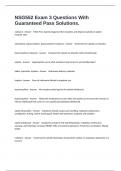NSG552 Exam 3 Questions With
Guaranteed Pass Solutions.
naloxone - Answer MOA: Pure opioid antagonist that competes and displaces opioids at opioid
receptor sites.
methadone, buprenorphine, buprenorphine+naloxone - Answer Treatments for opioid use disorder.
buprenorphine+naloxone - Answer Treatment for opioid use disorder with comorbid pain.
opioids - Answer Inappropriate use of what substance may be due to uncontrolled pain?
tablet, injectable, implant - Answer Naltrexone delivery methods.
implant - Answer Form of naltrexone limited to inpatient use.
buprenorphine - Answer Mu receptor partial agonist for opioid withdrawal.
buprenorphine - Answer Taking this medication too soon after last opioid use increases the chances of
intense withdrawal that comes on very quickly (precipitated withdrawal).
opioid intoxication - Answer Symptoms include nausea and vomiting, respiratory depression,
constipation, itching, mioisis (small pupil). Patient will experience euphoria and sedation.
opioid withdrawal - Answer Symptoms include N/V/D and dehydration, irritability, restlessness,
yawning, and twitching, increased HR/BP, chills, increased temperature, rhinorrhea, lacrimation, dilated
pupils.
naloxone - Answer Treatment for opioid intoxication during which cardiac or respiratory depression is a
concern.
, cocaine intoxication - Answer Symptoms include dilated pupils, HA, tremor, hyper-reflexia, twitching,
seizures, or coma, increased HR/BP, arrhythmias, and MI, N/V, incontinence/ARF, or rhabdomyolysis
cocaine intoxication - Answer Treatment includes BZD, antipsychotics, and management of medical
problems including HTN, stroke, cardiac arrhythmias, hyperthermia, and seizures.
cocaine - Answer The use of beta blockers for treatment of chest pain and MI during this intoxication is
to be avoided due to unopposed a adrenergic stimulation.
alcohol intoxication - Answer Signs vary with blood levels, from decreased reaction time, muscle
incoordination, ataxia, dysarthria, to respiratory failure and coma.
severe alcohol intoxication - Answer Treatment includes cardiopulmonary function maintenance,
thiamine, and haloperidol PRN agitation.
thiamine - Answer Given IM/IV for 3 days to prevent Wernicke's encephalopathy, along with IV fluids
and a banana bag.
benzodiazepines - Answer Class of drugs to avoid for acute alcohol intoxication.
uncomplicated alcohol withdrawal - Answer Treatment includes BZD in either symptom triggered or
fixed dose; diazepam and chlordiazepoxide have a longer half life, and oxazepam and lorazepam are
suitable for patients with hepatic dysfunction.
diazepam and chlordiazepoxide - Answer BZDs with a long half-life used to treat AUD.
oxazepam and lorazepam - Answer BZDs with moderate half-life used in AUD patients with liver
disease.
alcohol withdrawal seizures - Answer Treatment includes diazepam IV or lorazepam IV/IM, thiamine
IV/IM, and addressing electrolyte imbalances.




